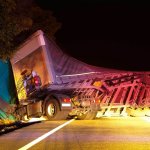Railroad Crossing Accidents
Tragic accidents occur every day at railroad crossings. The sudden impact of 400,000 pounds of steel is way too much for any vehicle to withstand, let alone an unfortunate motorist or pedestrian who happens to get hit by a train and killed or seriously injured.
Crossing train tracks is an everyday occurrence for many commuters in America, but some states present an especially high risk when it comes to railway safety. Unfortunately, Louisiana ranks among the worst states. Louisiana had the 7th highest number of railway intersection collisions in 2018, with an added shocking statistic: That same year, there were nearly two collisions between cars and trains every week in Louisiana.
In Acadiana, as we all know, there is an extensive railway system connecting metropolitan areas to the Mississippi River and to our various ports. In fact, a Rail Plan presented to the Louisiana Department of Transportation and Development acknowledged that Louisiana’s rail system plays an essential role in linking Louisiana shippers with markets throughout North America. It describes the Louisiana freight rail system which is operated by six large Class I railroads and 14 smaller local, switching, and terminal railroads. The system consists of 2,730 route miles, excluding leases and trackage rights.
As motorists, we encounter railroad crossings all the time but perhaps they are taken for granted because they are so prevalent in South Louisiana. Think of this – the average freight train needs over a mile to come to a complete stop, according to the Louisiana Department of Transportation and Development. That speaks volumes about the potential for injury upon impact.
According to Federal Railroad Administration statistics, there were 2,217 collisions in the United States between motor vehicles and railcars in 2018. All over the country, 262 people died in train-highway intersection collisions that year.
The personal injury lawyers at Joseph Joy and Associates argue that it is neither fair nor correct that so many railroad accidents are blamed on the motorist or pedestrian. There are a number of considerations that come into play when assessing the negligence of others involved in a railway accident.
For example, were the visual warning devices visible and in good working order? Louisiana law requires owners of public rail crossings to install various visual safety devices. For example, La. Rev. Stat. 32:169 sets forth detailed requirements for Public Railway Cross buck, stop and warning signs, traffic control devices:
- Any person, firm, or corporation controlling any railroad track which intersects a public road or street at grade crossings, except those contained in the maintenance system of the department, shall erect and maintain a “Railroad Cross Buck” sign at the crossings above referred to which shall be white with the “Railroad Crossing” in black letters…”
What about the locomotive horn? Did the operator sound the horn properly? Louisiana law sets forth specific requirements:
La. Rev. Stat. 32:168. Equipment of locomotive with bell and whistle or horn, sounding of signals
- Every railroad company or person owning and operating a railroad in this state shall equip each locomotive engine with a bell and a whistle or horn which, under normal conditions, can be heard at a distance of not less than one quarter of a mile.
- Except as specifically exempted by law, any person controlling the motion of an engine on any railroad shall commence sounding the audible signal when such engine is approaching and not less than one quarter of a mile from the place where such railroad crosses any highway. Such sounding shall be prolonged either continuously or by blasts of the whistle or horn to be sounded in the manner provided by the Uniform Code of Railroad Operating Rules until the engine has crossed the roadway, unless the distance from that crossing to the start of the movement or the distance between the crossings is less than one quarter of a mile, in which event such warning signals shall be so sounded for the lesser distance. In cases of emergency said whistles or horn may be sounded in repeated short blasts.
- The provisions of this Section shall not apply to the Kansas City Southern railroad line which runs parallel to Perkins Road in the city of Baton Rouge, Louisiana.
Every case is unique, with its own set of facts. There are also federal regulations that may be at issue-far too many legal considerations, state and federal regulations to cite them all here. But it does give you a sense of the complex nature of railroad crossing accidents.
Was the driver or pedestrian’s view obstructed, creating a danger? Was the view of the roadway obstructed so as to require the injured to place themselves in a dangerous position to view oncoming traffic and/or the tracks? Along those same lines, a high-volume, high-speed intersection can be considered “visual clutter” amounting to a hazard. These are just a few examples of the fact-specific inquiries that must be made.
Of course, motorists must heed standard safety considerations as well:
- Stop, look both ways, and listen. Remember that trains always have the right of way.
- Make sure you have room to get across. Once you enter the crossing, keep moving.
- Stop 15’ away from flashing red lights, lowered gates, a signaling flagman or a stop sign.
- Never try to drive around a lowering gate. Never ignore signals, and always use caution.
- Before you begin to cross, wait for gates to fully raise and for all lights to stop flashing.
- Never assume that there is only one train coming from a single direction.
- If your car stalls in a crossing, get out and call the number on the sign, or 911.
Source: National Highway Traffic Safety Administration
Nationally, a person is struck by a train every three hours. If you or a loved one has been involved in a collision at a railway intersection, they may not be the ones at fault. At Joseph Joy and Associates, we’ll know whether you’re entitled to compensation, and we can help you get the money you deserve. Please call us with any questions about your accident at (337) 232-8123.




